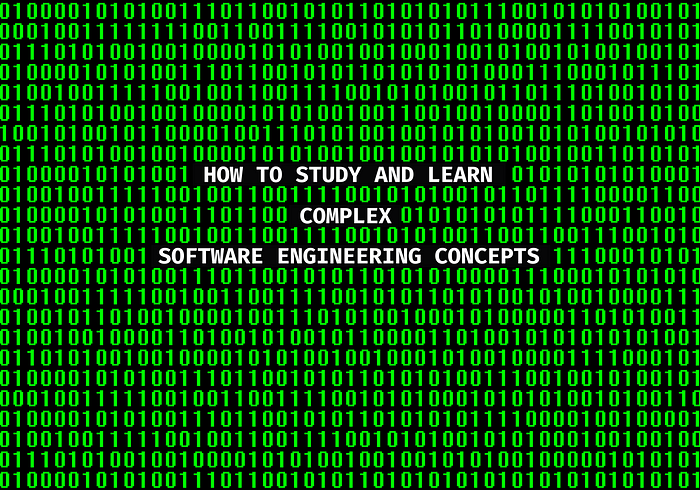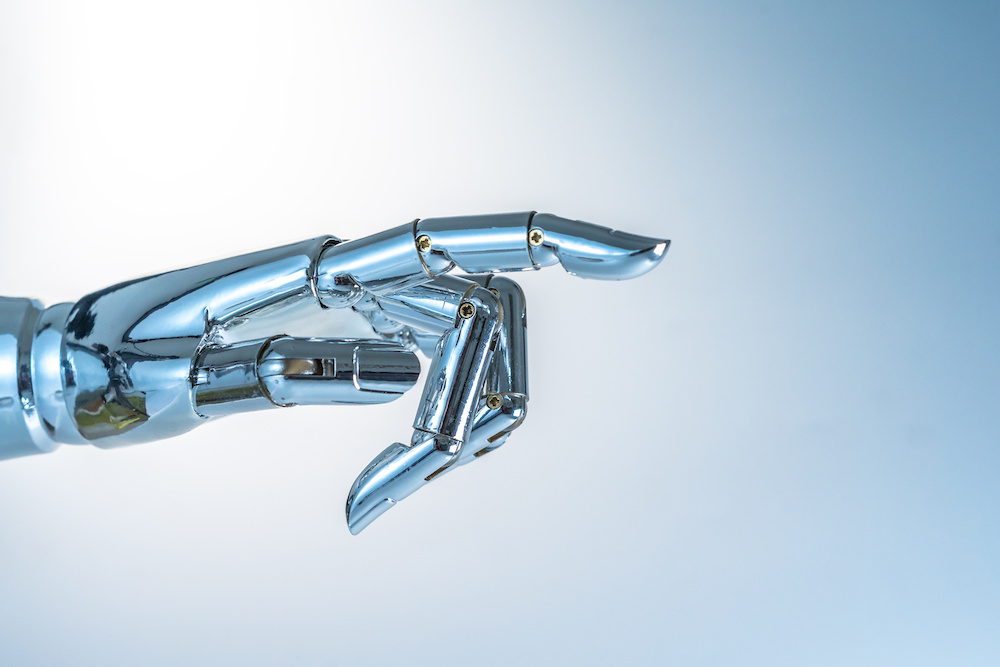How To Study and Learn Complex Software Engineering Concepts

Chunking is a powerful technique to learn new concepts by breaking big and
complex subjects down into smaller, manageable units that represent the core
concepts you need to master. Let’s say you would like to start your Data Science
journey. Grab a book or find a comprehensive online curriculum on the subject
and begin by scanning the table of contents and skim-reading the chapters by
browsing the headers, sub-headers and illustrations. This allows you to get a
feel of what material you are about to explore and make mental observations on
how it is organised as well as start appreciating what the big picture looks
like, so you can then fill in the details later. After this first stage, you
need to start learning the ins and outs of the individual chunks. It is not as
intimidating as you originally thought, as you have already formed an idea of
what you will be studying. So, carrying on our previous example, you can go
through the book chapters in-depth, and then supplement your knowledge by
looking at Wikipedia, watching video tutorials, finding online resources, and
taking extensive notes along the way.
RISC-V AI Chips Will Be Everywhere

The adoption of RISC-V, a free and open-source computer instruction set
architecture first introduced in 2010, is taking off like a rocket. And much of
the fuel for this rocket is coming from demand for AI and machine learning.
According to the research firm Semico, the number of chips that include at least
some RISC-V technology will grow 73.6 percent per year to 2027, when there will
be some 25 billion AI chips produced, accounting for US $291 billion in revenue.
The increase from what was still an upstart idea just a few years ago to today
is impressive, but for AI it also represents something of a sea change, says
Dave Ditzel, whose company Esperanto Technologies has created the first
high-performance RISC-V AI processor intended to compete against powerful GPUs
in AI-recommendation systems. According to Ditzel, during the early mania for
machine learning and AI, people assumed general-purpose computer
architectures—x86 and Arm—would never keep up with GPUs and more purpose-built
accelerator architectures.
Sustainable architectures in a world of Agile, DevOps, and cloud
Driving architectural decisions is an essential activity in Continuous
Architecture, and architectural decisions are the primary unit of work of a
practitioner. Almost every architectural decision involves tradeoffs. For
example, a decision made to optimize the implementation of a quality attribute
requirement such as performance may negatively impact the implementation of
other quality attributes, such as usability or maintainability. An architectural
decision made to accelerate the delivery of a software system may increase
technical debt, which needs to be “repaid” at some point in the future and may
impact the sustainability of the system. Finally, all architectural decisions
affect the cost of the system, and compromises may need to be made in order to
meet the budget allocated to that system. All tradeoffs are reflected in the
executable code base. Tradeoffs often are the least unfavorable ones rather than
the optimal ones because of constraints beyond the team’s control, and decisions
often need to be adjusted based on the feedback received from the system
stakeholders.
6 Cyber-Defense Steps to Take Now to Protect Your Company

Modern device management is an essential part of increasing security in remote
and hybrid work environments. A unified endpoint management (UEM) approach fully
supports bring-your-own-device (BYOD) initiatives while maximizing user privacy
and securing corporate data at the same time. UEM architectures usually include
the ability to easily onboard and configure device and application settings at
scale, establish device hygiene with risk-based patch management and mobile
threat protection, monitor device posture and ensure compliance, identify and
remediate issues quickly and remotely, automate software updates and OS
deployments, and more. Choose a UEM solution with management capabilities for a
wide range of operating systems, and one that is available both on-premises and
via software-as-a-service (SaaS). ... Companies should look to combat device
vulnerabilities (jailbroken devices, vulnerable OS versions, etc.), network
vulnerabilities and application vulnerabilities (high security risk assessment,
high privacy risk assessment, suspicious app behavior, etc.).
Europe proposes rules for fair access to connected device data

The Data Act looks to be a key component of the EU’s response to that threat.
... Secondly, the Commission is concerned about abusive contractual
terms being imposed on smaller companies by more powerful platforms and market
players to, essentially, extract the less powerful company’s most valuable data
— so the Data Act will bring in a “fairness test” with the goal of protecting
SMEs against unfair contractual terms. The legislation will stipulate a list of
unilaterally imposed contractual clauses that are deemed or presumed to be
unfair — such as a clause that states a company can unilaterally interpret the
terms of the contract — and those that do not pass the test will be not be
binding on SMEs. The Commission says it will also develop and recommend
non-binding model contractual terms, saying these standard clauses will help
SMEs negotiate “fairer and balanced data sharing contracts with companies
enjoying a significantly stronger bargaining position” Some major competition
complaints lodged against tech giants in the EU have concerned their access to
third party data, such as the investigation into Amazon’s use of merchants
data
Mind of its own: Will “general AI” be like an alien invasion?

Yes, we will have created a rival and yet we may not recognize the dangers right
away. In fact, we humans will most likely look upon our super-intelligent
creation with overwhelming pride — one of the greatest milestones in recorded
history. Some will compare it to attaining godlike powers of being able to
create thinking and feeling creatures from scratch. But soon it will dawn on us
that these new arrivals have minds of their own. They will surely use their
superior intelligence to pursue their own goals and aspirations, driven by their
own needs and wants. It is unlikely they will be evil or sadistic, but their
actions will certainly be guided by their own values, morals, and sensibilities,
which will be nothing like ours. Many people falsely assume we will solve this
problem by building AI systems in our own image, designing technologies that
think and feel and behave just like we do. This is unlikely to be the case.
Artificial minds will not be created by writing software with carefully crafted
rules that make them behave like us.
5 ITSM hurdles and how to overcome them

Unclear communication makes it far more difficult to explain the value of ITSM
to the business, to properly organize ITSM efforts, to set expectations for its
deployment and to secure proper funding for it. Hjortkjær suggests using the
CMDB to map IT components to business applications, assign ownership of those
applications to both IT and business sponsors, and ask those sponsors to explain
the role of each application to the business, as well as how best to use it and
eventually when to replace it. Thomas Smith, director of telecommunications and
IT support at funeral goods and services provider Service Corp. International,
recommends being candid about schedules. “One of the biggest mistakes we made in
the past, and still make, is to say `We’re going to get it done in three
months.’ Four months later, everyone is still hoping for three months,” he says.
Understand any deficiencies in your ITSM tool or services, he recommends, “and
tell the business process owners `We have a plan to address it.’” Calvo says the
terms of SLAs, such as those it created using BMC’s HelixITSM platform, can help
set expectations and reduce frustration from users who “think everything should
be solved ASAP.”
Data Mapping Best Practices
Many applications share the same pattern of naming common fields on the frontend
but under the hood, these same fields can have quite different labels. Consider
the field “Customers”: in the source code of your company’s CRM, it might still
have the label “customers”, but then your ERP system calls it “clients”, your
finance tool calls it “customer” and the tool your organization uses for
customer messaging will map it “users” altogether. This is one of the probably
most common data mapping examples for this label conundrum. To add to the
complexity, what if a two-field data output from one system is expected as a
one-field data input in another or vice versa? This is what commonly happens
with First Name / Last Name; a certain customer “Allan” “McGregor” from your
eCommerce system will need to become “Allan McGregor” in your ERP. Or my
favorite example: the potential customer email address submitted through your
company’s website will need to become “first-name: Steven”, "last-name: Davis”
and “company: Rangers” in your customer relationships management tool.
How to perform Named Entity Recognition (NER) using a transformer?

Named entities can be of different classes like Virat Kohli is the name of a
person and Lenovo is the name of a company. The process of recognizing such
entities with their class and specification can be considered as Named Entity
Recognition. In traditional ways of performing NER, we mostly find usage of
spacy and NLTK. There can be a variety of applications of NER in natural
language processing. For example, we use this for summarizing information from
the documents and search engine optimization, content recommendation, and
identification of different Biomedical subparts processes. In this article, we
aim to make the implementation of NER easy and using transformers like BERT we
can do this. Implementation of NER will be performed using BERT, so we are
required to know what BERT is, which we will explain in our next section. In
one of the previous articles, we had a detailed introduction to BERT. BERT
stands for Bidirectional Encoder Representations from Transformers. It is a
famous transformer in the field of NLP. This transformer is a pre-trained
transformer like the others.
Using artificial intelligence to find anomalies hiding in massive datasets
To learn the complex conditional probability distribution of the data, the
researchers used a special type of deep-learning model called a normalizing
flow, which is particularly effective at estimating the probability density
of a sample. They augmented that normalizing flow model using a type of
graph, known as a Bayesian network, which can learn the complex, causal
relationship structure between different sensors. This graph structure
enables the researchers to see patterns inartifi the data and estimate anomalies
more accurately, Chen explains. “The sensors are interacting with each
other, and they have causal relationships and depend on each other. So, we
have to be able to inject this dependency information into the way that we
compute the probabilities,” he says. This Bayesian network factorizes, or
breaks down, the joint probability of the multiple time series data into
less complex, conditional probabilities that are much easier to
parameterize, learn, and evaluate.
Quote for the day:
"It's not about how smart you
are--it's about capturing minds." -- Richie Norton
No comments:
Post a Comment